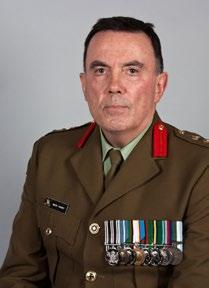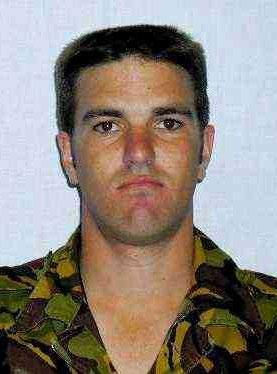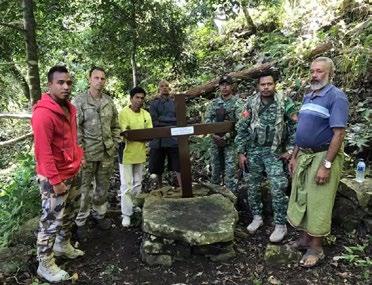
5 minute read
Remembering PTE Manning
A MESSAGE FROM ASSISTANT CHIEF OF ARMY (RESERVES)
CHANGES AHEAD FOR ARMY RESERVE
Advertisement
Solid analysis on changes to the Army Reserve, and a strong future focus on NZ Army outputs will see positive changes on the horizon for the NZ Army Reserve Force.
This means Reserve Force growth, stronger integration, and focused training are on their way to ensure the Army Reserve is best prepared to support their Regular Force counterparts and the needs of New Zealand.
The role of the Army Reserves in the other ABCANZ armies has been clearly laid out for some time but in New Zealand, clarity around the Army Reserve role as part of NZ Army capability has taken longer to define.
The ongoing Force Design process – optimising the garrison structure of the NZ Army to maximise the ability to sustain current and future operational deployments up to and including Multi Role Battalion Group – has indicated that Reserve personnel will be required for sustainment, sometimes earlier in the deployment cycle than had been anticipated. It is also clear that the Reserves should be engaged in a wider range of tasks than has been the case in recent years.
The Reserve Contribution to Outputs paper was presented at the Army Leadership Board in June.
The paper discussed areas of risk and gaps that appeared from the modelling, how those gaps might be filled and the arrangements that are needed to better allow Reservists to participate in and contribute to wider Army activities, including operational deployments.
We have identified where the Army Reserve could fill these gaps and how it should be configured to do that, and we are working with the Force Design project to fully define the Reserve outputs.
The Chief of Army, Major General John Boswell, made his concerns clear early in his appointment when he reiterated that he was not prepared to see the Reserve ‘wither on the vine’ in his tenure. This was followed up by his direction to move the three Reserve infantry battalions from under command TRADOC to 1(NZ) Brigade command arrangements in 2019. The plan presented to the Leadership Board includes growth of the Ready Reserve to 1,500 by 2025, with that growth prioritised for infantry, engineers and logisticians and an expanded set of tasks for the infantry. The plan also includes training on the various support weapons, reconnaissance and surveillance, and the ability to generate a force element up to company level for operations.
There is significant work to prepare for and execute what will be the most significant change in the role of the Army Reserve for some decades. The planning for this will focus on the integration of the Regular and Reserve Force, how growth of the Ready Reserve will occur, how training will expand and, in certain instances, be done differently, and the other enabling activities that will be required to ensure success.
Five Corps have been analysed in this planning phase: RNZA, RNZAC, RNZIR, RNZE and RNZALR.
This change is timely, and reflects the needs of the NZ Army as part the Army 25 plan. This is not a cold start – the Army Reserve has been more prominent in recent years both in providing individuals to deploy on overseas operations, and in significant input to the NZDF’s contribution to operations within New Zealand – including the Christchurch earthquakes, the Op Rena oil spill in the Bay of Plenty, regional flooding and fires, and most recently the NZDF input into Covid-19.
This next step-change recognises the military professionalism and expertise of the Regular Force, which can be bolstered with the range of skills, commitment and enthusiasm within the Army Reserve – strengthening our ability to connect with wider New Zealand and sustain operations.
Assistant Chief of Army (Reserves) Colonel Bede Fahey
Remembering Private Manning


Three Memorial services are to be held in Timor Leste to commemorate 20 years since Private Len Manning was killed in action on Foho Debalulik in a militia ambush on 24 July 2000.
Two services will be held in Cova Lima on 24 July 2020, one on Foho Debalulik at 1030 in the location, marked by a cross, where Len Manning was killed, and one at the Tilomar F-FDTL Base at 2pm next to the cross erected by B Coy, NZBATT2 in 2000. Additionally there will be a Memorial Service in the New Zealand Embassy at 5.30pm on 25 July 2020.
Lieutenant Colonel Martin Dransfield who was PTE Manning’s Commanding Officer at the time of his death will speak and read a short message from his parents, Charlie and Linda, followed by the New Zealand Ambassador, Phil Hewitt, who will also read a message from Minister Ron Mark. LTCOL Dransfield is the Strategic Advisor to Falintil-Forças de Defesa de Timor-Leste.
The service in Dili will be next to the Kiwi Stone laid by the last NZ Contingent of the International Stabilisation Forces in 2012, and the memorial plaque which was unveiled by Minister Ron Mark as part of the Interfet memorial activities last year. At the service on 25 July the Ambassador will also acknowledge the sacrifice of the seven Kiwis who died during Timor Leste’s struggle for Independence and whose names are on the memorial plaque: Gary Cunningham 16 October 1975 at Balibo Kamal Bamadhaj 12 November 1991 Santa Cruz massacre, Dili WO2 Tony Walser 30 November 1999 SSGT Billy White 25 April 2000 PTE Len Manning 24 July 2000 PTE Boyd Atkins 14 Mar 2001 PTE Dean Johnston 28 July 2002 To mark the 20 th anniversary of PTE Manning’s death, two of the job training centres in Lalawa and Belulik Leten, where Len and many other Kiwi Soldiers were based from 1999 till 2002, will be opened.
The Len Manning Trust has sponsored students for many years to attend technical colleges focussing on vocational training. Last year the Ambassador Small

Grants Fund was used to purchase equipment for the Technical Training Centre in Salele. As part of the students’ training in carpentry, electricity, plumbing, plastering, and welding they will do on the job work in the two Len Manning Training Centres in Lalawa and Belulik Leten.
Other activities include, through Australian Veterans and Timor Awakening, the donation of much needed beds and equipment to the Suai Hospital, the building and opening of the new Cova Lima Radio Station. The Len Manning Foundation will make donations to the Uma-Mahon (Safe Home), in Salele which supports women and children, and an orphanage.
Above, L–R: WO2 Aaron French, NZ BATT interpreter Francisco Arthouse, locals and F-FDTL members at a memorial cross for PTE Manning on Foho Debalulik; Private Len Manning. Below, L–R: The memorial plaque; The Tilomar Base Memorial Cross. LTCOL Dransfield is centre.


